NDVI stands for "Normalized Difference Vegetation Index". NRG stands for "Near-infrared / Red / Green". NDVI and NRG are both ways to visualize the amounts of infrared and other wavelengths of light reflected from vegetation. Because both these methods compare ratios of blue and red light absorbed versus green and IR light reflected, they can be used to evaluate the health of vegetation. It's a snapshot of how much photosynthesis is happening. This is helpful in assessing vegetative health or stress. (Read more here: https://www.agronomy.org/publications/jeq/articles/36/3/832) ## Do-It-Yourself These techniques for vegetation analysis were developed for satellite imagery, but at Public Lab, we've been working a lot on capturing infrared imagery using our DIY [near-infrared camera](/wiki/near-infrared-camera) setup, and combining it with visible bands to produce NDVI images such as the one above. ## What these images mean What exactly are these images we're trying to make? What do they tell us about vegetation, and why? These diagrams should help to understand what it is we're doing and why these are good ways to analyze plant life. ## The NDVI equation [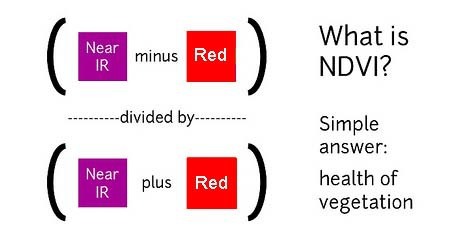](/i/44723) **NDVI = (Near Infrared - Red)/(Near Infrared + Red)** NDVI is a ratio which tries to emphasize photosynthesis while filtering out sun glare. The above equation is run for every pixel, using source data from an infrared photo and a visible light photo, like this pair: [](https://publiclab.org/system/images/photos/000/021/771/original/5390895115_c9d4d38fec_o.jpg) The result can be false-colored to make the high-photosynthesis areas more clear, and used to examine where plants are and how healthy they are. [](https://publiclab.org/system/images/photos/000/021/770/original/PetVISNDVIcomp.png) _Figure above: Normal color photo (right) and normalized difference vegetation index (NDVI) image (left). NDVI image was derived from two color channels in a single photo taken with a camera modified with a special infrared filter. Note that tree trunks, brown grass, and rocks have very low NDVI values because they are not photosynthetic. Healthy plants typically have NDVI values between 0.1 and 0.9. -- @cfastie_ ### Activities Here are a range of activities you can do to produce and interpret your own NDVI imagery, whether downloaded from a satellite imagery provider or [collected yourself using a DIY technique](/wiki/multispectral-imaging) [activities:ndvi] ****   Most DIY converted cameras today (those from Public Lab) use RGN instead of NRG, so the blue channel represents infrared instead of the red channel. That looks like this: [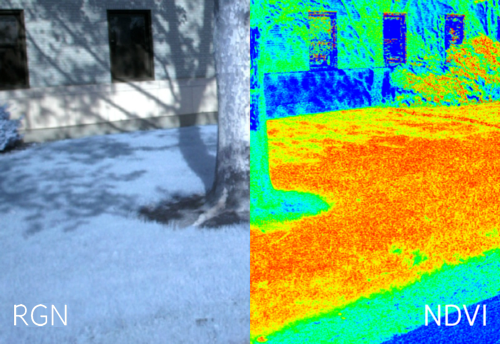](/i/45468?s=o) **** ## NRG imagery Some people are also interested in producing NRG imagery (like the below image), where `Near-Infrared, Red, and Green` are used to compose a picture instead of the usual `Red, Green, and Blue`. [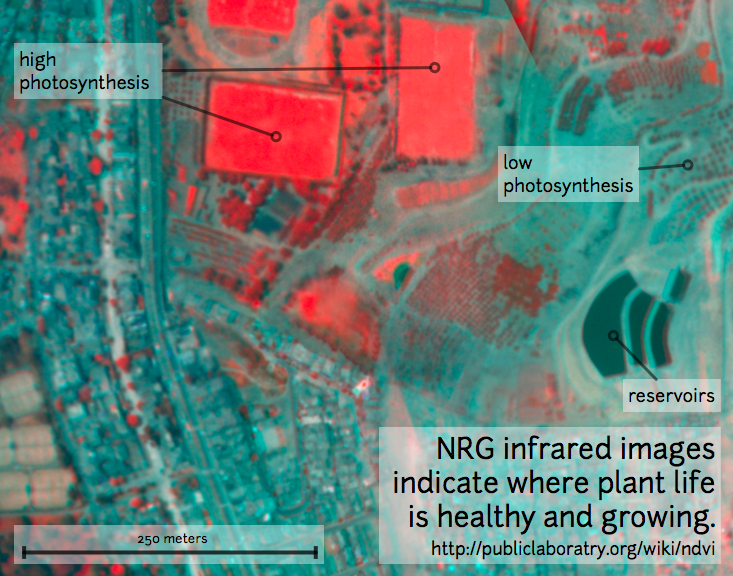](/i/25064) This diagram explains the swapping, which allows us to 'see' infrared as if it were a normal color: [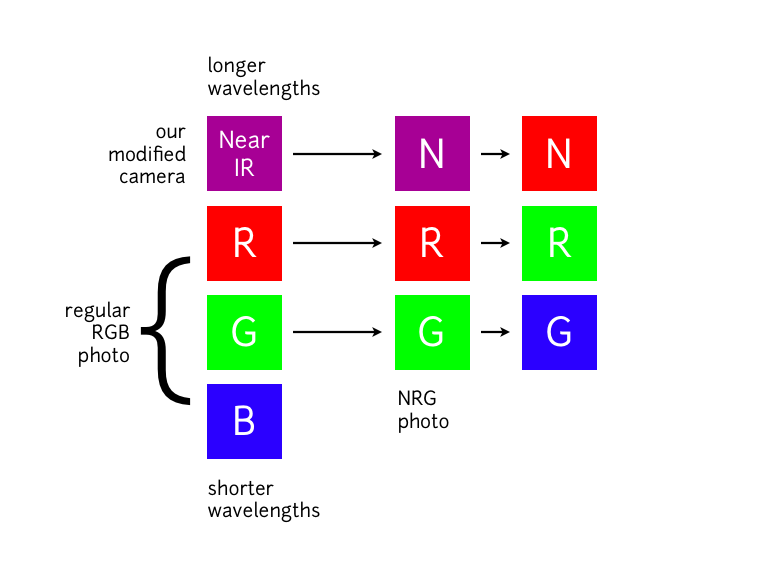](/i/25063) **In NRG images, the deeper and clearer the red color, the denser and healthier the vegetation (more or less).** ### Questions [questions:ndvi] ### Other examples of DIY NDVI imaging From around the internet: Begin watching at 2 minutes to see the resulting imagery: *This topic is part of the [Grassroots Mapping Curriculum](/wiki/mapping-curriculum) series.* **** [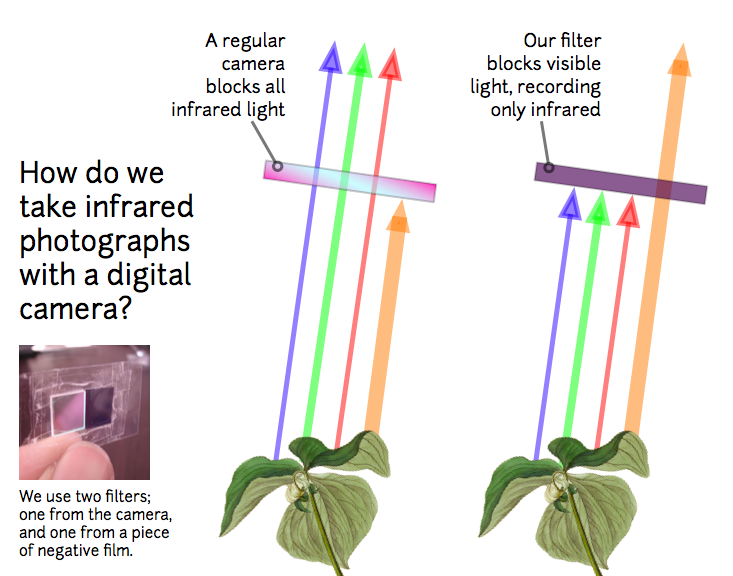](/i/25066) [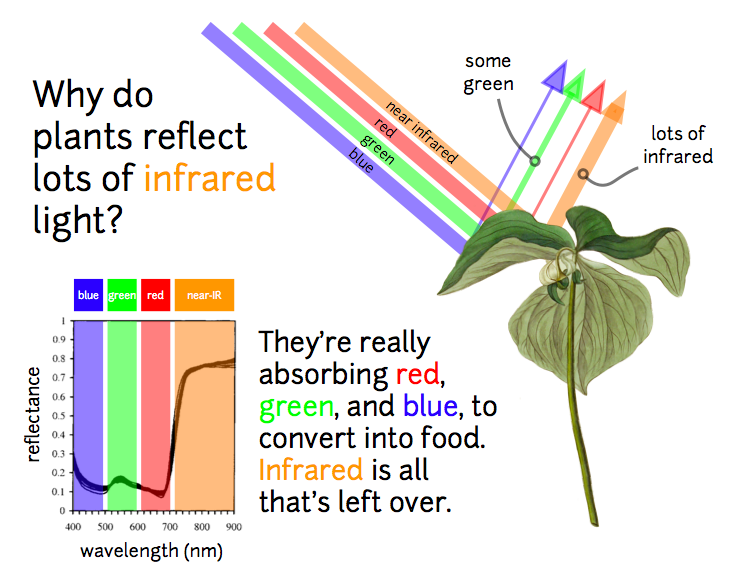](/i/25065) ...
| Author | Comment | Last activity | Moderation | ||
|---|---|---|---|---|---|
| cfastie | "There are a few options for getting both a visible light image and an NIR image of the same scene. The DIY approaches vary in their ability to dist..." | Read more » | about 9 years ago | |||
| Steven | "Thanks @cfastie ... So, are you saying this would be a matter of using one camera with the blue filter and one camera with the Rosco #19 "Fire" fil..." | Read more » | about 9 years ago | |||
| cfastie | "Hi Steven, This type of analysis should be viable. I have not seen examples of pure NIR photos providing more information than good normal photos ..." | Read more » | about 9 years ago | |||
| Steven | "@warren, Thanks for the response, that's interesting, but not exactly what I am looking for. I am actually interested in trying to identify subsurf..." | Read more » | about 9 years ago | |||
| warren | "Hmm, you should check out this video as an example -- is this close to the technique you're looking for, albeit of a different subject? https://pub..." | Read more » | about 9 years ago | |||
| Steven | "@warren, I was wondering if it would it be possible to use a variation of this technique to combine a series of images taken over the course of a g..." | Read more » | about 9 years ago | |||
| jkridner | "I can't seem to find the layout or code. Can anyone share a link or two? " | Read more » | about 9 years ago | |||
| Tbtouaki | "Hi @Jakub I re-read lots and lots of posts here, but basically depending on the IR filter you use, you should use a color card, a red card to set ..." | Read more » | about 9 years ago | |||
| Jakub | "Hi! @Tbtouaki Could You explain, how You calibrated the WB on Your camera? Best regards, Jakub " | Read more » | about 9 years ago | |||
| Jogomez74 | "Cfastie and Agustin If we try to change de index co-dominium? I mean 0 to 1. And the equation of NDVI index must be.. NDVI 1= (1/2)(NDVI+1) = (1/2)..." | Read more » | about 9 years ago | |||
| nedhorning | "Unfortunately those values would only work if you had the same materials that I used. To get the reflectance values you would either need to fine s..." | Read more » | over 9 years ago | |||
| aldehyde | "How to get target reflectance values for the visible and near-infrared wavelengths that correspond with the camera filter? Can I use?. 0.7529225,0..." | Read more » | over 9 years ago | |||
| nedhorning | "Hi aldehyde - Did you look at the user guide on Github: https://github.com/nedhorning/PhotoMonitoringPlugin that should have information about crea..." | Read more » | over 9 years ago | |||
| aldehyde | "Please help. If it is possible to describe all the work with the plugin. How to create "сomma-separated variable (CSV) file with the reflectance v..." | Read more » | over 9 years ago | |||
| nedhorning | "Mathew - Have you been able to find a reflectance plot for those paints? I looked but didn't see it. Other paints I was looking at a couple years a..." | Read more » | over 9 years ago | |||
| mathew | "Rosco manufactures outdoor-grade TV paints including 60% grey (TV white) and black (3%) and chroma colors (blue, green). They would be good choices..." | Read more » | over 9 years ago | |||
| CHUMBA | "Hello @cfastie, thanks for your opinion it really help us out. We are so new on this issue, as I commented you on other talk we just broke a camera..." | Read more » | over 9 years ago | |||
| amck | "I can actually provide a, perhaps, useful comment to your drone question. One reason I chose to use the 130IS was that it is very light. Mine wei..." | Read more » | over 9 years ago | |||
| cfastie | "I'm not sure how different the NIR signal will be when using a Rosco #2007 vs. #19 or other red filter. Both will allow capture of some distributio..." | Read more » | over 9 years ago | |||
| amck | "Thanks for the reply Chris. Your observations are very insightful. My thoughts are currently toward reproducing some of your tests with hooking u..." | Read more » | over 9 years ago | |||
| cfastie | "I see what you mean about the green channel being almost as bright as the red channel. The Rosco 2007 filter blocks almost as much green as red, so..." | Read more » | over 9 years ago | |||
| Monoxyde | "Thank you, I thought, that by offering to plugin a VIS photo plus a NIR photo, Shooting by two identical cameras with the same parameters ISO etc ...." | Read more » | over 9 years ago | |||
| cfastie | "I am not sure what your question is. You could use the two-camera feature of the plugin but give it the same Wratten 25 photo for both the VIS and ..." | Read more » | over 9 years ago | |||
| Monoxyde | "Chris, do you feel that the Photomonitoring plugin is able to work better if I provide two images (from a modified camera and the other by the same..." | Read more » | over 9 years ago |